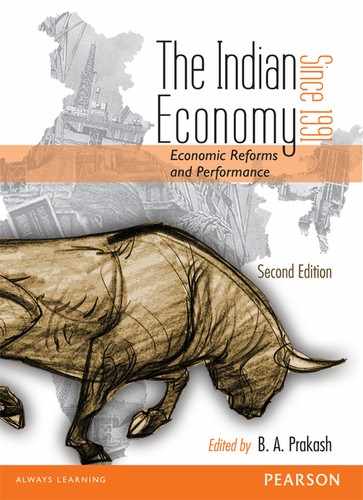Appendix 1
Industrial Policy Reforms, 1991–95
The major policy changes initiated in the industrial sector from July 1991 include the removal of entry barriers, reduction of the areas reserved exclusively for the public sector, rationalization of the approach towards monopolistic and restrictive practices, liberalization of the foreign investment policy, far-reaching liberalization of the import policy with respect to intermediate and capital goods, measures to bring about regional balance, especially the development of backward areas, and encouraging the growth of the employment-intensive small and tiny sector.
- The number of items in respect of which industrial licensing remains is reduced to 15. These industries account for only 15 per cent of the value added in the manufacturing sector.
- The number of industries reserved for the public sector is reduced to six, namely defence products, atomic energy, coal and lignite, mineral oils, railway transport and minerals specified in the Schedule to the Atomic Energy Order, 1953. Private participation in some of these sectors is also permitted on a case-by-case basis.
- More private initiative is encouraged in the development of infrastructure like power, roadways, telecommunication, shipping and ports, airports and civil aviation, etc.
- The manufacture of readymade garments—an item reserved for exclusive manufacture by the ancillary/small-scale industrial undertakings—is opened to large-scale undertakings, subject to an export obligation of 50 per cent and an investment limit of Rs 3 crore.
- Automatic approval is granted of foreign investment up to 51 per cent and foreign technology agreements are permitted for 35 priority industries, which account for about 50 per cent of the value added in the manufacturing sector.
- Foreign investment liberalized in many other sectors.
- The Foreign Investment Promotion Board established to negotiate with large international firms and to expedite the required clearances.
- Technology imports for priority industries are automatically approved for royalty payments of up to 5 per cent of domestic sales and 8 per cent of export sales or for lump sum payments of Rs 1 crore.
- A National Renewal Fund is set up with a corpus of Rs 200 crore to ensure that the costs of technological change and modernization of industry would not be borne by the workers.
- The MRTP Act is amended to eliminate the need for the prior approval of capacity expansion or diversification by large companies.
- The requirement of phased manufacturing programmes discontinued for new projects.
- Government clearance for the location of projects is dispensed with, except in the case of 23 cities with a population of more than one million.
- Small-scale enterprises are given the option to offer up to 24 per cent of their shareholding to large-scale and other industrial undertakings. This is to provide them with greater access to capital and technology.
- To enable the public sector to work efficiently, public sector units are given the greatest autonomy.
- The Government undertakes limited disinvestment of a part of the public sector equity to the public through public financial institutions and mutual funds.
- The government amends the Sick Industrial Companies Act to bring public sector undertakings within its purview. This makes sick public sector units subject to the same discipline as private sector units.
Small-Scale and Village Industries
New policy measures were taken for promoting and strengthening small, tiny and village enterprises. The main thrust of the new policy is to impart more vitality and growth to employment and exports. The salient features of the new policy are:
- De-regulation, de-bureaucratization and simplification of statutes, regulations and procedure.
- Increase in the investment limit in plant and machinery of tiny enterprises from Rs 2 lakhs to Rs 5 lakhs, irrespective of the location of the unit.
- Inclusion of industry-related services and business enterprises as small-scale industries, irrespective of their location.
- Ensuring adequate flow of credit on a normative basis, and quality of its delivery for viable operation of the small-scale sector.
- Setting up of a special monitoring agency to oversee the genuine credit needs of the small-scale sector.
- Introduction of a suitable legislation to ensure prompt payment of bills of small industries.
- Introduction of a scheme of Integrated Infrastructure Development (including technological back-up services) for small-scale industries.
- Setting up of a technological development cell in the small industries development organization.
- Market promotion ofsmall-scale products through co-operative/public sector institutions, other specialized professional/marketing agencies and the consortia approach.
- Setting up of an export development centre in the small industries development organization.
Fiscal Incentives
- Excise concessions for both registered and unregistered units on a graded scale, depending on turnover of up to Rs 300 lakhs.
- A scheme of integrated infrastructure development launched in March 1994 to strengthen the infrastructure in rural and backward areas.
- Quality Certification Scheme launched to improve small-scale product quality. Financial support to acquire ISO 9000.
- Seven Point Action Plan initiated to improve credit flow to small-scale sectors.
- Scope of the National Equity Fund scheme enlarged to cover the whole country, except metropolitan areas, to support expansion, modernization and technology upgradation.
- The Technology Development and Modernization Fund scheme launched for the modernization and adoption of improved and updated technology.
- A scheme for creation of Technology Development Fund in the States launched with the involvement of the state government and industry associations.
Credit Policies
- Priority sector lending.
- The 40 per cent of advances to the small-scale sector reserved for tiny sector, and village and cottage industries.
- Refinance facilities and special schemes of the Small Industries Development Bank of India (SIDBI).
- Concessional/fixed rates of interest for loans of up to Rs 2 lakhs (two slabs).
- Single Window Scheme of the SIDBI for project outlays of up to Rs 50 lakhs.
- Under Prime Minister’s Rozgar Yojana, loans sanctioned to 31,971 micro enterprises in 1993–94; 196,133 enterprises in 1994–95 and 101,321 enterprises between April and November 1995.
Source: Economic Surveys, 1991–92 to 1995–96.
